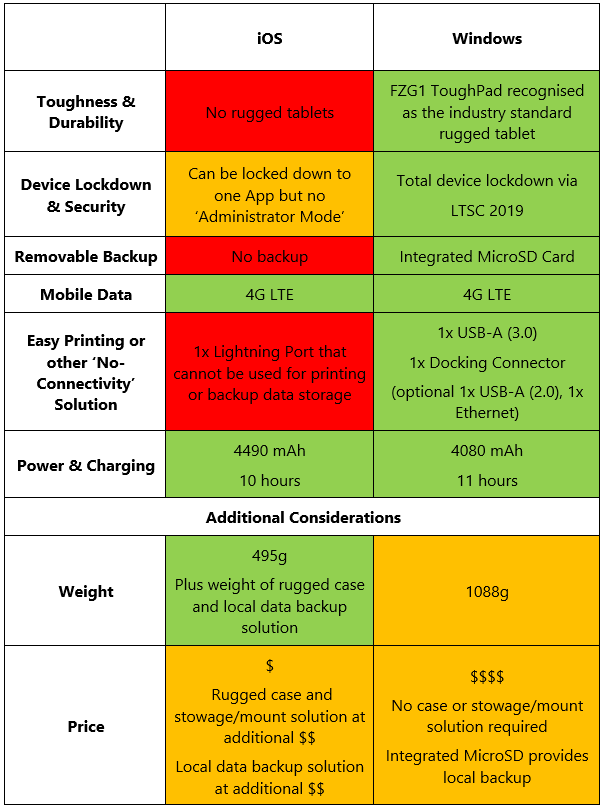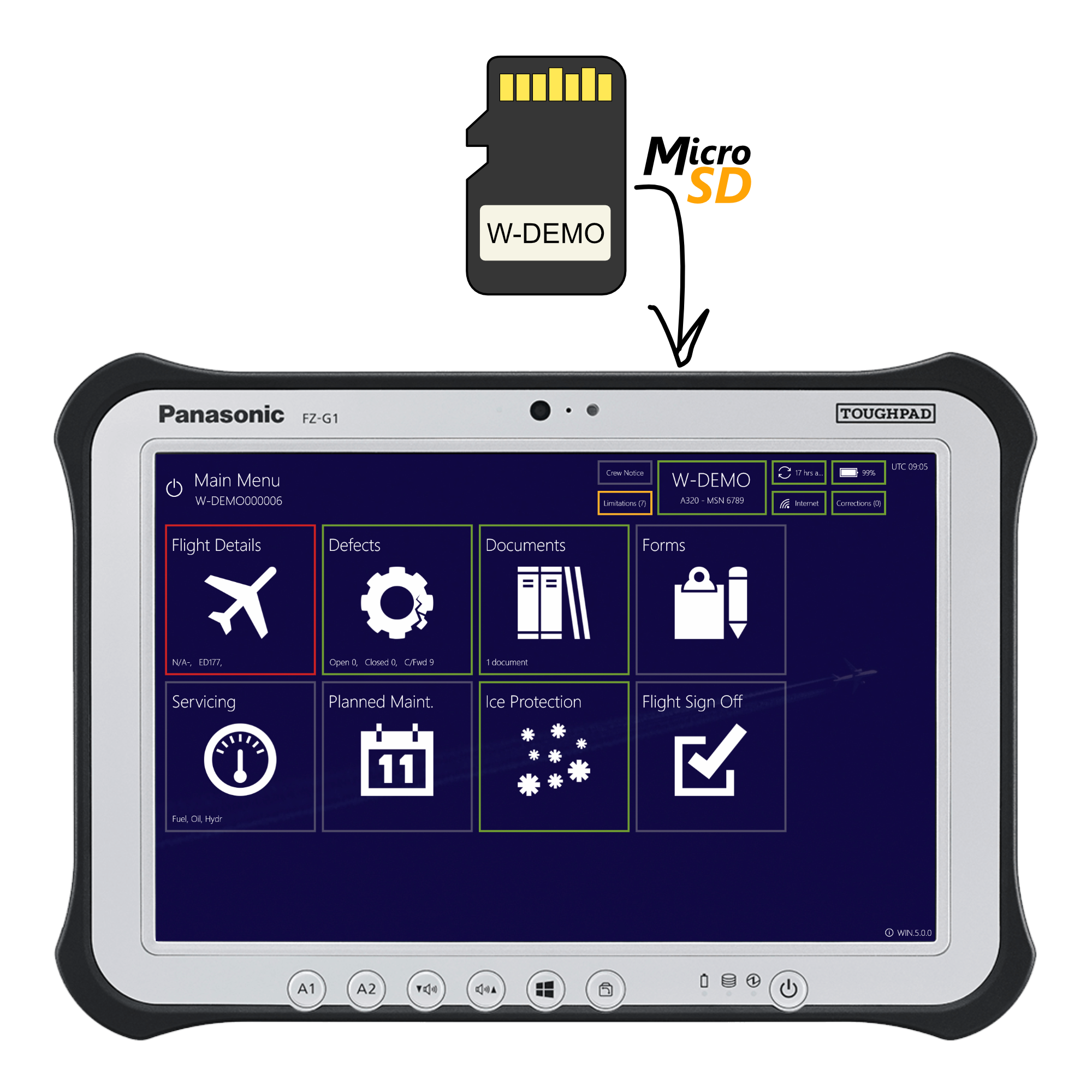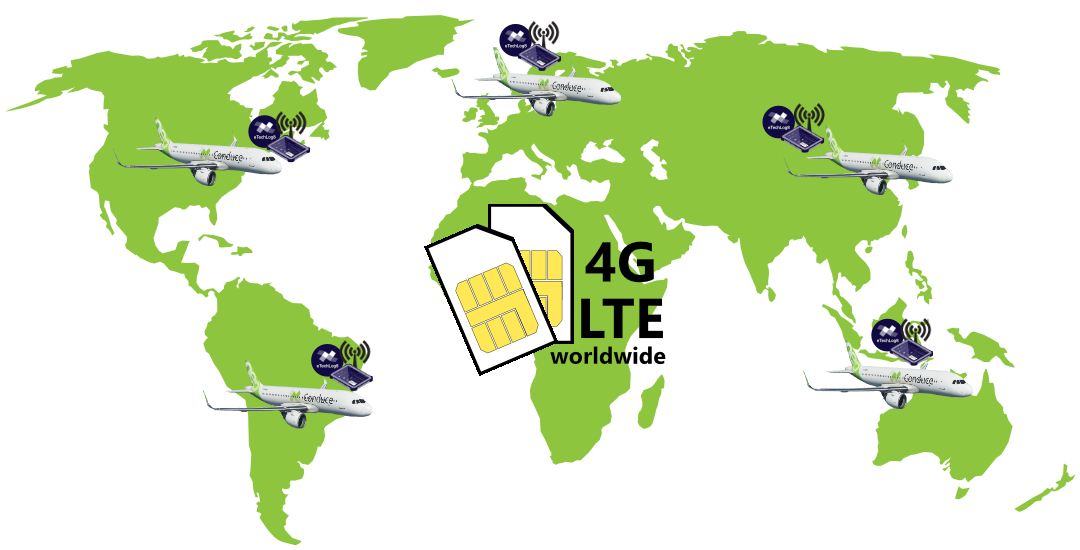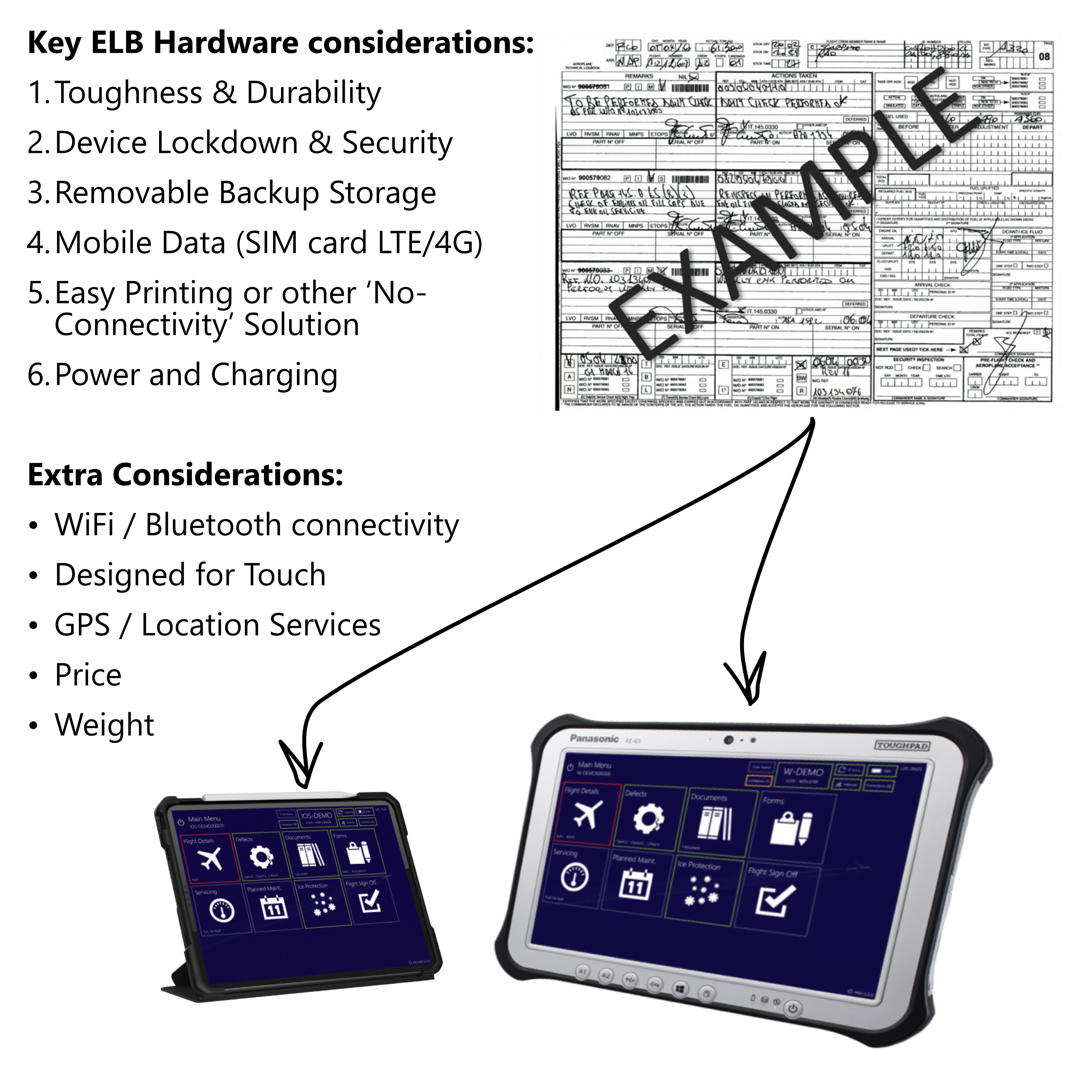12th March 2021
Tags: ELB, eTechLog8, ios, PaperLess Operations, windows

So, you’ve decided to implement an Electronic Technical Log (ELB), rid yourselves of paper carbon copy books and join the 21st Century – hooray! But first there is an important decision to be made; should you choose an iOS or Windows device?
This is a question that comes up in nearly every demo, every webinar and every proposal we’ve ever done at Conduce. eTechLog8 is available on both iOS and Windows (and it is identical on both platforms), but to date our customers worldwide have unanimously chosen to host eTechLog8 on Windows devices; more specifically, the Panasonic FZG1 ToughPad. We’ve looked at the key considerations when choosing ELB hardware below.
What about other Operating Systems?
Whilst Android is the most used operating system on tablets worldwide, it is universally considered not secure enough for front-line avionics equipment, so the choice is realistically between Windows and iOS.
What should you be taking into consideration when choosing ELB hardware?
We’ve identified six key things to consider for ELB hardware selection:
- Toughness & Durability
- Device Lockdown & Security
- Removable Backup Storage
- Mobile Data (SIM card LTE/4G)
- Easy Printing or other ‘No-Connectivity’ Solution
- Power and Charging
We’ve looked at the iPad Mini and the Panasonic FZG1-5.
1. Toughness & Durability
We must first be clear that an ELB should not be a personal issue device. Instead it should be aircraft-assigned and largely live in the cockpit/on the line and be used by multiple Pilots and Engineers all over the world in various climates every day.
The toughness and durability of the device is therefore extremely important. The ELB will be dropped, occasionally sat on, subjected to coffee spills and worse. They will be used above and below wing over a long-term contract. A device may be used to record an undercarriage defect and rested on a tire before falling into a puddle or drip tray. The ELB devices will suffer temperatures of -40 to +60 degrees Celsius and they will be abused by a wide variety of users.

iOS does not have a dedicated Rugged design for these kinds of conditions. On Windows there are far more options and some, like the Panasonic ToughPad, even have international DO-160 level cockpit hardware approval.
The design limited lifespan (18 months to two years) of an Apple device is an additional point to be considered, as replacing mission critical equipment for an aircraft is costly and far more expensive than just the cheap device cost.
In Conduce’s experience, Panasonic ToughPads usually last five years or more. UK TV Show, The Gadget Show, tested the toughness of the ToughPad in an episode in 2014 with impressive results:
The Gadget Show tests the Panasonic ToughPad’s ruggedness!
2. Device Lockdown and Security
As a mission critical piece of avionics equipment, by design, the ELB device needs to be totally locked down and very difficult to interfere with. A normal user should not be able to do anything on the device apart from the specified ELB processes. It should not be possible to get into the Operating System, wander around the file system or launch an internet browser to post on social media or play games. If total lockdown of the device is not enforced, then the integrity of the device and hence the ELB system is compromised. Data could be corrupted, interfered with or stolen.
Uncontrolled operating system updates can also pose a problem for ELB devices, as the operating system updates may not have been tested in conjunction with the ELB software, resulting in the fleet wide ELB failure.
iOS devices can be locked down to a specific app in a variety of ways, one of which is the “Guided Access” feature. There is no concept of user security within iOS as all devices are designed to be personal use, so every user has administrator privileges. iOS updates can be controlled through a professional Mobile Device Management (MDM) solution. However, this is always a temporary reprieve as the iOS devices need to stay current to operate effectively.
The 2019 release of Windows 10 Long-Term Servicing Channel (LTSC) provided an ideal Operating System for a Windows ELB. New versions of LTSC are only released every 3 years, but each release is fully supported with security updates for 10 years – and never any “Feature Updates”. It can be heavily customized and severely locked-down to a single app.

3. Data Backup
Another key requirement is for the ELB hardware to have two independent data storage locations. This is essential as operational data loss due to storage hardware failure is unacceptable. This problem does not exist on paper!
This is a key concern of Airworthiness Authorities, who will normally require assurance that the Tech Log Page (TLP) data is stored in at least two independent locations. One of these can be the local SSD or Device memory drive, but there needs to be an independent local backup.
At Conduce we believe that best practice is that the restore process should be possible in the Cockpit on a spare device without an internet connection and take only a minute or so.
iOS devices can only be connected physically via the lightning port and do not have an integrated SD card slot. WiFi or Bluetooth must be used to connect to a backup device such as an SD card in order to mirror the data. As the backup drive should be updated automatically whenever data is saved on the device, this runs this risk of quickly becoming impractical and time consuming.
For Windows devices this is usually this is in the form of a backup SD card, to which the device data is mirrored. In the event of primary device storage failure, the data can quickly be retrieved from the removable SD card.
4. Mobile Data
Any ELB must be able to transmit data quickly, securely and from anywhere in the world. The ELB should operate normally with or without an internet connection. When a connection is available the ELB device should benignly transmit the queued sector data without interrupting the user experience or aircraft operation.
A 4G LTE enabled device with worldwide data roaming is therefore essential to any ELB solution. The SIM contracts should be managed by your ELB provider as part of a turnkey solution; otherwise your ELB provider cannot guarantee their solution and efficiently fix problems when they happen.
Conduce have negotiated a worldwide “data only” roaming contract with Vodafone, via our partner Daisy Communications. This enables eTechLog8 to benefit from worldwide 4G data roaming at a very affordable rate. Mobile Device Management, the SIM contracts and all software and hardware is included as part of a “monthly tail fee”.
The ELB will be heavily used during aircraft turn arounds. These are often very short – sometimes 30 mins or less. In a modern 4G environment, speeds of around 20Mbits/sec can be expected, with 50Mbits/sec being routinely observed in Europe and the Middle East.
Both the iOS and Windows devices have 4G LTE connectivity.

5. Easy Printing or other ‘No-Connectivity’ Solution
Remember that a digital or paper copy of the certified TLP must be left on the ground prior to every flight, even when an internet connection is not available.
An internet connection may be unexpectedly unavailable for many reasons: in some parts of the world the internet is still unreliable and may be turned off at a moment’s notice for nefarious political reasons. Commercial Internet Service Providers (ISP’s) will occasionally go down for technical reasons or just because of human error.
A UK national mobile data provider for 32 million customers failed for 24 hours during December 2018. This sort of event must be assumed will happen again. Any ELB solution that totally relied on that ISP would have had a serious problem, it is essential the ELB can operate normally without an internet connection and, if necessary, for multiple days/sectors.
Our preferred Windows device, the Panasonic FZG1-5 ToughPad, has a USB-A port that can be quickly and easily connected to a printer, enabling TLPs to be printed with just a few taps.
We are yet to find a quick and easy solution to this problem for iOS. We’ve experimented with USBs, device cloning, QR codes and all sorts of other technology, but none of these solutions have been selected by our customers.

6. Power and Charging
The ELB device is likely to be used both in the Cockpit and on the Line and needs to be charged and ready to go when you need it. Consider how and when the device is going to be charged.
For our preferred hardware, the Panasonic ToughPad, we have integrated charging into the Charging and Printer Kit. This is designed to be plugged into the aircraft 115V AC supply in the cockpit (aka the Hoover socket).
ToughPad Charging Stats:
- Charges from 0 – 100% in 90 minutes.
- Uses approximately 3% per TLP – on a busy operation it will last in excess of 2 days.
- Recommended to charge ToughPad daily in order to keep charge in excess of 60%.
Since many airlines already have iOS EFB or Crew issue devices, it is likely that iOS device charging has already been considered.
iPad Charging Stats:
- Charges from 0 – 100% in 300 minutes.
- No data on battery use per TLP.
- Recommended to charge iPad daily in order to keep charge in excess of 60%.
Other Considerations
There are some other factors that airlines will want to take into consideration when selecting ELB hardware. These are all items that will not prevent the ELB functioning as the legal TLP but may offer significant benefits.
- WiFi / Bluetooth allows for integrations with other devices & systems such as eCabinLog8, which uses WiFi peer to peer pairing.
- The device should be designed for touch, and not require a stylus. At Conduce, we also believe that ELB software should be “Fat Finger Friendly” and not require your finger stab to be perfectly accurate.
- GPS (or other location services) offering location tracking enable smart features like this one on eTechLog8: if you enter a landing airport geographically far away from your current location, eTechLog8 will flag this and suggest you double check the data before signing the page. This is useful for unexpectedly diverted flights.
- Price tags. Airlines will be looking for a balance between suitable device performance and price.
- Weight. Every kg adds up!
As above, all current Conduce customers have eventually selected the Windows Panasonic ToughPad solution, even though in many cases the iPad solution was initially preferred. We hope this article aids any airlines considering an ELB solution to decide between iOS and Windows.

Tweet

